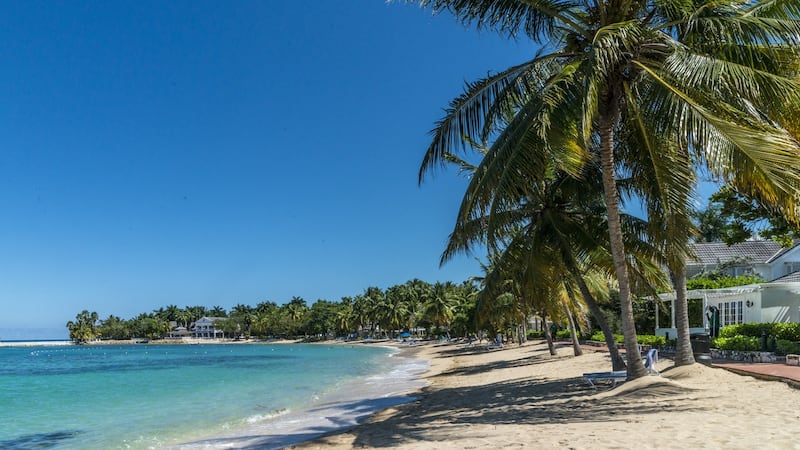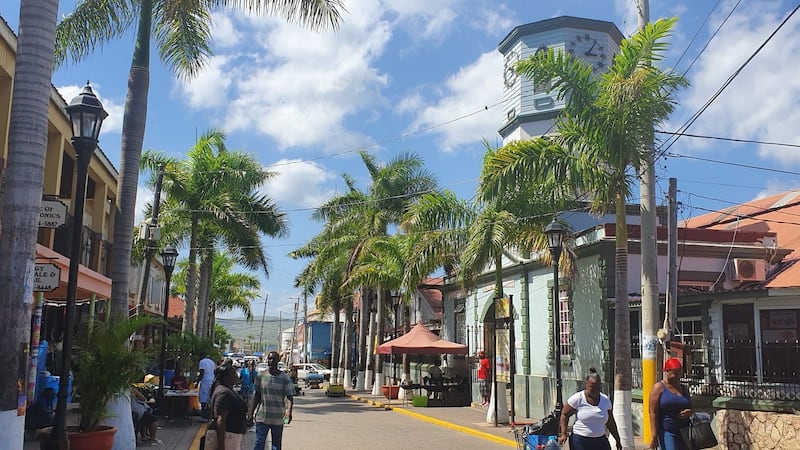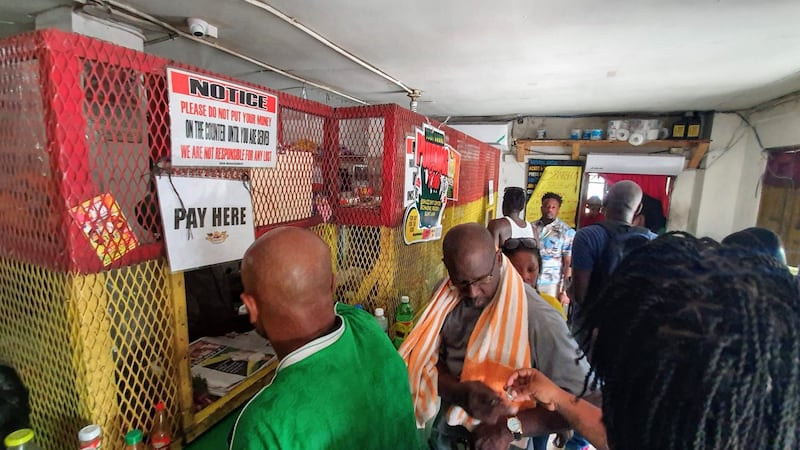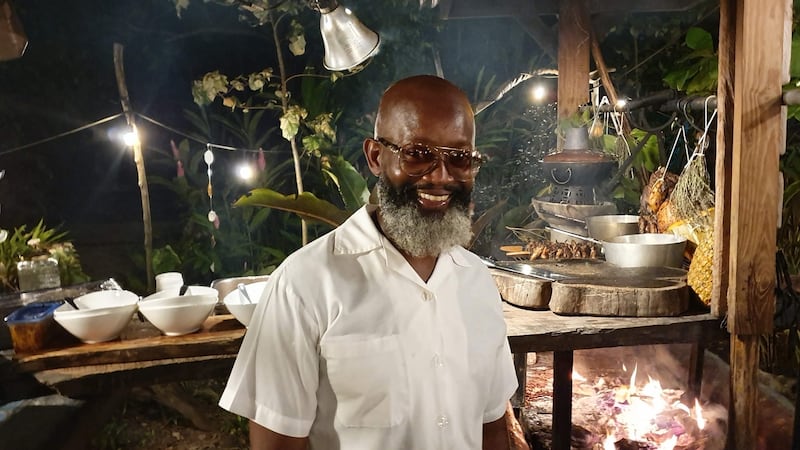You'd catch the aroma of Scotchies before you'd notice its sign. The smoky, meaty scent emanating from this famous jerk restaurant drifts all the way out into the humid Montego Bay street; it's enough to make me and my Jamaican driver, Willie, duck out of the traffic and make a quick stop.
Inside – using the term loosely as it’s more of a shack – the chefs are the first to greet us. On two monumentally large grills, a grid of marinated spatchcock chickens and large cuts of pork sit directly on top of pimento wood, and underneath sheets of corrugated iron that probably wouldn’t pass more stringent health and safety checks. Still, they’re one of the most famous hotspots for jerk cooking on the island, and it’s as popular with Jamaicans like Willie as it is for blow-ins like me.
Marinated in a wet rub then a dry rub, left overnight, then cooked to preserve the smokiness, it’s served chopped up in tinfoil. The meats are everything you’d expect them to be: flavoured through with the deep jerk seasoning, moist and moreish.
But Scotchies is the only place that honours my preconception about Jamaican food – I’d imagined endless meals of jerk meats plus rice’n’peas, served with sides of plantains, yams and ackee (whatever ackee is), with a pineapple and coconut dessert. The truth is, that’s only one cuisine of many.

Today's Jamaica is one of fine dining and fusion food, world-class coffee and indulgent treats like pudding cakes – plus a touch of Irish influence where it matters. On an island loaded with fresh vegetables and fruits, and an abundance of fish off its tropical shores, good food is its currency – it's how families spend time together and friends express affection. On Jamaica's coat of arms, you'll find five pineapples, the symbol of hospitality that stems from the Caribbean.
Tourism
It's an effective symbol. Every year, 4.5 million people visit, and seven out of 10 people live in households involved in tourism. Given this reliance, it's a relief to see swathes of this mountainous island free of the gawdiness that comes with an international influx – just avoid Negril, with its American-esque sports bars, night clubs and Bob Marley wigs, as fetching as they are. Instead, soundtracked by the man himself, and reggae versions of classics like "What a Wonderful World" and "Fast Car", we snake around the unspoilt coast and rev our way up the expanse of the Blue Mountains, whose turquoise-tinged eucalyptus trees give rise to their name.
We’re on a road trip to scour the island for delicious delights in Jamaica, and they’re not hard to find. On the roadside with sweeping views, Eits Cafe serves Ital food. Rather than the raw, vegan movement I thought it was, it’s simply about avoiding processed food, so meat is on the menu too. The Sugar Mill is accepted as one of the country’s best fine-dining experiences, and it’s just on the doorstep of my hotel, the Half Moon. In the small fishing village of Port Royal – where groups of kids on the street stare at unfamiliar cars as if UFOs have landed – Gloria’s serves up grilled, whole fish straight from the boat.
I can’t come to Jamaica and forgo the fruits that grow freely. Near Usain Bolt’s hometown to the north of the island, the colonial area of Falmouth is heaving on cruise ship days, but when we visit, we have the place to ourselves. So we bother the sleeping fruit sellers on the roadside for their freshly-picked produce, like lychee and sugar cane. Jackfruit, the vegetarian’s ingredient du jour, is sweet and meaty in its raw form, which feels odd to my tastebuds. But the mangoes are divine. About 20 varieties grow in Jamaica, and any person off the street will be able to name at least three – especially with memorable names like East Indian, Black, Bastard, Bombay, Graham, Julie, Keith, Number 7, Number 11, Red Jaw, Sweetie Come Brush Me and Tommy Atkins. About €1 each, I try a few, and each is more mouth-watering than the next; some are fleshier, others dribble down my chin and onto my clothes (no regrets), some carry a depth of flavour and others are light and moussey.

The most important port of call is to the cacophonous capital of Kingston, because patties are Jamaica’s signature dish. Forget about the Tayto and King crisp rivalry – here, it’s all about Juici and Tastee. Tastee began in 1966; Juici in 2016. Tastee is the market leader; Juici has the most stores. At the behest of my knowledgeable guide, Stacian Virtue, we go our separate ways (yes it’s safe enough) to buy a mix of the chicken, beef and vegetarian varieties from each, as well as Mother’s, a smaller contender, and carry out a taste test in the car. Tastee’s pastry is noticeably more shortcrust, and Juici’s flakier. But the winner is Mother’s, much to Stacian’s surprise. There’s a nice amount of filling, lighter pastry and bolder flavours. Plus, not a soggy bottom in sight.
Culture and tradition
While Jamaica was the first Caribbean country to gain independence from the British Empire in 1962, the long journey to this goal explains why culture and tradition bear extra importance. The language of patois began as a deliberately skewed version of English during slavery, and it’s everywhere today. As he drives, Willie teaches me phrases complete with Jamaican accent. Frankly, copying terms like “wah gwan” (“how are you”), “weh yuh deh pan” (“what are you doing”) and “smallup yuhself” (“move over”) feels offensive, especially when I’m cajoled into using it outside our safe space of the car. But he sees it as integration, and who am I to argue?
Conversely, the influence of the Irish, sent here by the British in the 17th century, seems to have dissipated. It lives on mostly in the azure blue eyes or freckly skin of many citizens, if not their surnames – one in four Jamaicans have Irish ancestry. On a day-to-day level, Jamaica’s Irish past is apparent under the bright lights of the supermarket. In the vegetable section of Hi Lo, I find a tumbling mass of potatoes labelled “Irish potatoes”. I tell Stacian that I’m aghast at the stereotype, but she looks at me blankly. “That’s just what they’re called, because the Irish used them so much.” Fair enough.
In the drinks section, there are rows of Irish Moss, a protein drink made from Carrageen moss: algae found in Jamaica that Irish immigrants noticed was similar to the moss consumed from Irish shores. It’s blended with milk, honey, spices and oats to make a thick, creamy milkshake drink that’s popular with Jamaican men – it’s said to make gents better in bed. I crack open a can of the suggestively-named Big Bamboo to try it, and while the sweet, vanilla flavour is more pleasant than I imagined, it’s too thick and gelatinous to be palatable for me. Then again, I suspect it’s not drunk primarily for its taste.
Sweet treats
Our next drive leads us to the famous Pudding Man in the small coastal village of Priory, whose roadside cookshop you’d drive past if it wasn’t painted with bright red, yellow and red stripes. Inside, it’s heaving with people keen for a slice of his pudding, purported to be the best in Jamaica. I queue up for a couple of slices, and it’s worth the wait. The cornmeal pudding is nothing to look at but it’s dense and chewy, like a fully soaked bread and butter pudding. The sweet potato pudding is sweeter still, and gooey like a treacle tart.

While we could feast all day on roadside food and sweet treats, we need to save room for our gourmet dinner. For this finale, we drive another 20 minutes to Hermosa Cove, an out-of-the-way beachside boutique hotel that’s favoured by celebrities in need of a low-key break – you don’t stay in rooms, you hire villas, and they’re lost behind thick, palm-ferned foliage. Here, I find chef Conroy Arnold busy preparing that evening’s barbecue feast. A former chef at Nobu New York, he returned home 12 years ago to oversee the cuisine at music mogul Chris Blackwell’s resort of GoldenEye before moving to this luxury hideaway.
Known as the Stuttering Chef for a speech impediment that’s all but disappeared now, he explains his approach while in the impossible heat of his outdoor kitchen. “Whenever you speak of food in Jamaica, you know it will be flavourful,” he says. “I like cooking meat so that it’s not just hot – that’s why I try to use ingredients like sugar and vinegar, so that you’ll taste spiciness, sweetness and bitterness in a complimentary way. And I always try to balance out the meat with a range of sides: greens, roast potatoes, salsa – little things that make a varied meal.

“When it’s done right, Jamaica’s cuisine is the best in the world,” he adds. “I can go down to Ochi market, which is five minutes away, to pick up fresh vegetables, or I can buy fish that’s hauled in from the boat that day. Then when you combine these ingredients with flavours, spices and seasoning, it results in tasty, honest food.”
Remembering my feast of experiences as his family style dishes are brought out, tempting in their aromas and vividly coloured under the candlelight of the beachside table, I couldn’t agree more.
Getting there
Delta operate indirect flights from Dublin to Montego Bay or Kingston from €619.
Where to stay
Half Moon, Montego Bay: rooms start from €380 per night per room. halfmoon.com
Hermosa Cove, Ocho Rios: one-bed villas start from €350 per night. hermosacove.com
Sandals, Montego Bay: seven nights in the Oceanfront Honeymoon Club Level Room with balcony and tub start from £2,075 (€2,401) per person including flights from London. sandals.co.uk
What to do
For more information on restaurants, tours and more, see visitjamaica.com.











